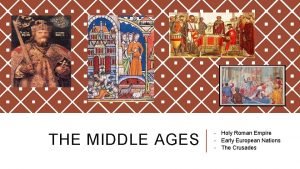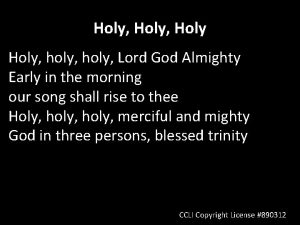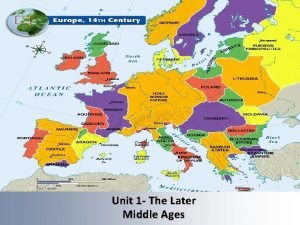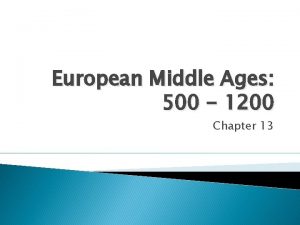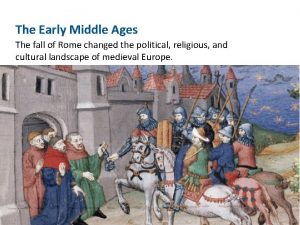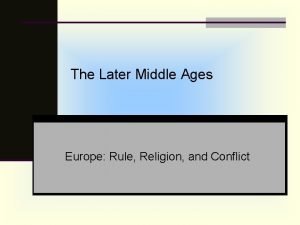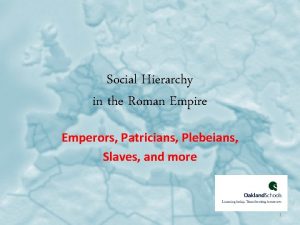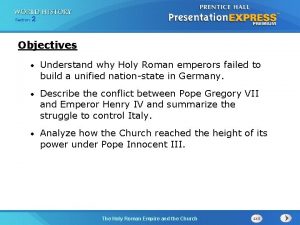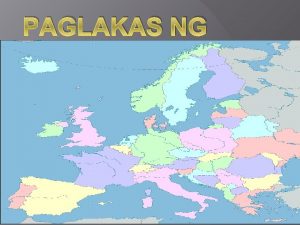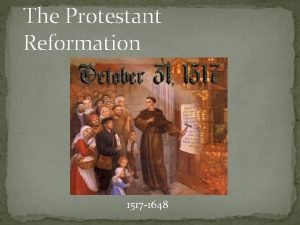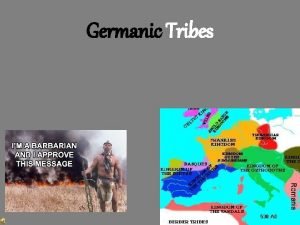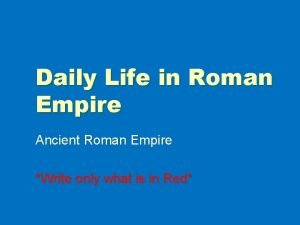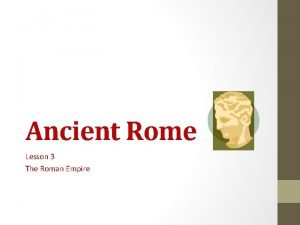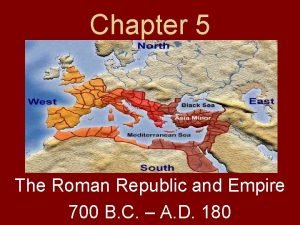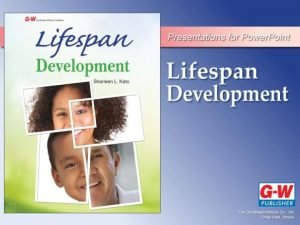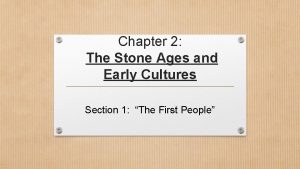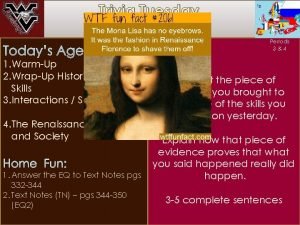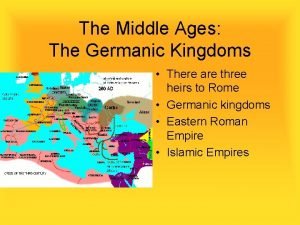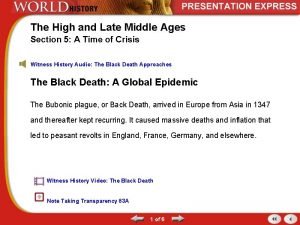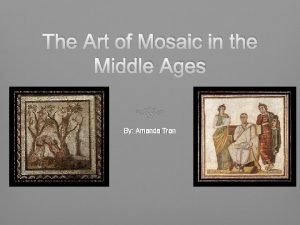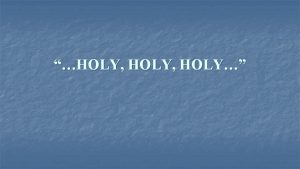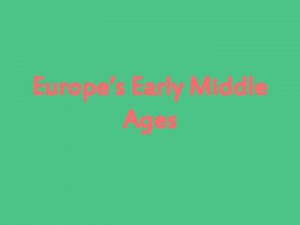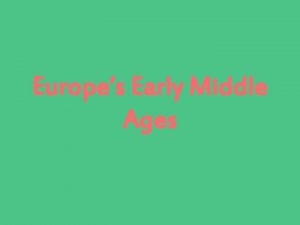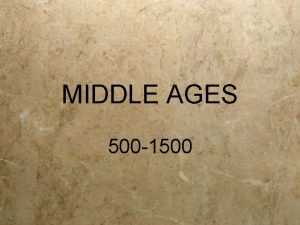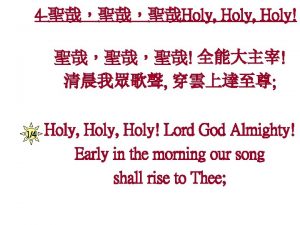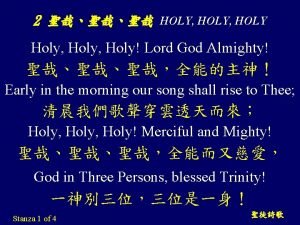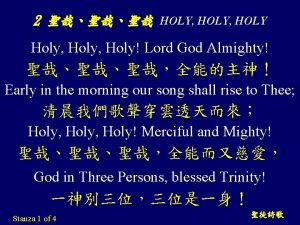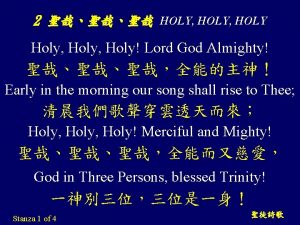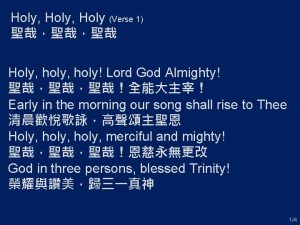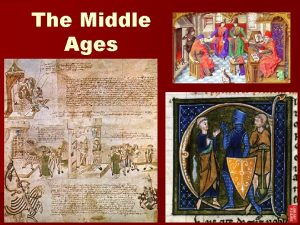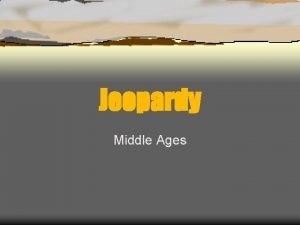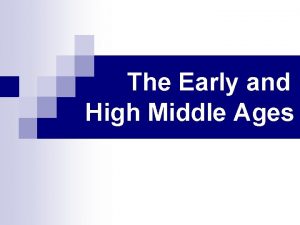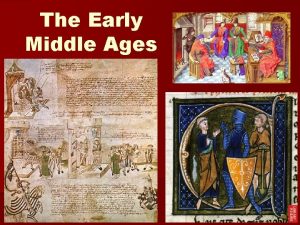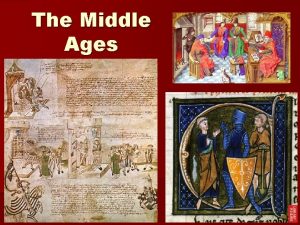THE MIDDLE AGES Holy Roman Empire Early European

























- Slides: 25

THE MIDDLE AGES - Holy Roman Empire - Early European Nations - The Crusades

CORNELL NOTE-TAKING METHOD Notes color-coded in RED go on this side of the line. Notes color-coded in BLUE go on this side of the line. These items will include: Supporting details Dates, Times, and Biographic details Vocabulary Definitions Main Ideas Big Concepts Vocabulary Words These items will include: Any items in BLACK text are optional. Remember: the more thorough your notes, the more prepared you will be for exams.

THE DARK AGES - Germanic Kingdoms - Barbarians - Vikings

INTRO TO THE MIDDLE AGES v. Medieval- comes from the Latin meaning “middle”; refers to the transition period from ancient to modern times v. Main Ideas: v. Theology becomes more important, will become a major factor in relations between Christianity & Islam, resulting in the Crusades v. Trade routes open communication between groups, allowing for the diffusion of culture, religion, math, and science v. Spread of diseases will wipe out large portions of population, especially the Black Death v. Nations begin to take shape, and certain families will be designated as their protectors

DARK AGES: TURMOIL IN EUROPE v. Germanic Kingdoms- formed out of early barbarian tribes; lived in small communities with unwritten customs, led by kings and warrior nobles based on loyalty v. Most successful Germanic Kingdom was established by the Franks v. As a result of Germanic invasions: v. Trade declined v. Roads, bridges, and cities fell into disrepair v. No written laws or enforcement v. No learning except in monasteries v. Loss of a common language due to many dialects v. Time period is often referred to as “Dark Ages”

DARK AGES: v. Barbarians- members of various Germanic TURMOIL IN EUROPE tribes who were not of Roman descent; they invaded parts of Europe and set up their own kingdoms in former provinces of Roman empire v. Constant warfare between groups disrupted trade and travel became unsafe v. Magyars- early Hungarian people, once hired as mercenaries by the Byzantines, converted to Christianity v. By the 900 s, the Magyars had reached Gaul and southern Italy v. Fight and pillage like Vikings vdefeated by Saxons, forced into central Europe v. Attacks cease in 955

DARK AGES: TURMOIL IN EUROPE v. England was under Roman control until 410 CE v. Angles and Saxons- migrated from continent to England, filled power vacuum after fall of Rome v. This is where “Anglo-Saxon” comes from v. Vikings- originally from Scandinavia (Modern Denmark, Norway and Sweden); dominated Northern Europe from about 700 to 1100 CE, v. Raided European towns and settled in other areas v. Name 'Viking' means “pirate raid“ in Old Norse

BUILDING EUROPEAN NATIONS - Holy Roman Empire England France Spain

HOLY ROMAN EMPIRE: v THE FRANKS Franks- Germanic group in Gaul, converted to Catholicism & align with the Church, founded the Merovingian dynasty which ruled the Franks for 200 years v. United by King Clovis I v. Charles Martel- known as “Charles the Hammer”, became “Mayor of the Palace” (majordomo) in 714 CE v. Battle of Tours- led by Charles Martel in 732 CE, the Franks stopped the spread of Islam into Europe v. Pepin the Short- Charles Martel’s son; a strict Catholic, he protected Catholic Church against the Lombards, an invading Germanic tribe v. The Church anointed him “King by the Grace of God” v. Carolingian Dynasty– founded by Pepin the Short, the family ruled over majority of Western Europe from 751 -987 CE

HOLY ROMAN EMPIRE: CHARLEMAGNE v. Charlemagne- son of Pepin the Short; ruled from 768 -814 CE, and was known for extending Frankish Empire, spreading Christianity, & encouraging learning v. Holy Roman Emperor- a reward for years of protecting and serving the Catholic Church, Charlemagne was crowned with new title on Christmas Day, 800 CE by Pope Leo III v. Charlemagne’s grandsons fought for control of the empire after his death v. In 843, they signed the Treaty of Verdun, which divides the empire into 3 kingdoms. v. One kingdom will evolve into France, while the other two will become Germany and the Low Countries

v BUILDING NATIONS: ENGLAND v Alfred the Great- unites Anglo-Saxon kingdoms in the 870 CE, defended the kingdom against Viking conquest Æthelstan- Alfred’s grandson, became the first King of England, and established the House of Wessex as the ruling family, in 927 CE v. Defeated an invasion by the King of Scotland v. Descendants would continue to fight foreign kings for control of England throughout their reign v. His line continued until Edward the Confessor died without an heir in 1066 v. Bayeux Tapestry- embroidered cloth that serves as historical account of William the Conqueror’s invasion of England defeat of Harold of Wessex to claim the throne of England v. Common Law- development began in 1066 and reformed over many years, mostly during rule of Henry II. Introduced the use of juries and allowed judges to form a unified body of law based on previous decisions

BUILDING NATIONS: ENGLAND v. Plantagenet- French noble family who ruled England beginning with Henry II in 11261485; warrior family who expanded territory but would lose central powers of the throne v. Magna Carta- signed in 1215 by King John, son of Henry II and brother of Richard the Lionheart, limited royal power for the first time. v. Guaranteed free men rights to a trial by jury and property protection and promised protections for the Church. v. Created a council of nobles the King had to listen to before creating new taxes. v. Origins of current Constitution & Parliament in UK

v. France- After breaking off from Holy Roman Empire, is a collection of small feudal lands that are very valuable BUILDING NATIONS: FRANCE & SPAIN v. Capetians- dynastic noble family founded by Hugh Capet after he was elected to throne by nobles in 987 CE v Will eventually expand control, enlarge territory & appoint loyal officials across France v. Spain- Visigoths on the Iberian peninsula convert to Christianity in 587 v. Muslims- controlled territory in Spain, north Africa, Mediterranean islands, Middle East and sought to establish a stronghold in Europe v. Becomes one cause of the Crusades v. Influenced architecture, art, and city-planning v. Reason why many Spanish & Arabic words sound the same v. Reconquista- Spanish wars and battles beginning in 772 CE to reclaim Muslim territory, lasts over 700 years (to 1492).

FEUDAL SOCIETY - Manorialism - Social Classes - Feudal Japan

FEUDAL SOCIETY: SOCIAL CHARACTERISTICS v. To protect themselves from violence and provide for basic economic needs, Western Europeans adopted the Franks’ feudal society. v. Kings granted a feud (or fief), land ownership, to a nobleman (vassal) in exchange for his loyalty and aid during war v. Strict class structures formed on the basis of land military power v. Mobility between classes was limited, people could not change their social positions v. Lord – had total authority over his lands, collected rent, settled disputes, provided military defense during war v. Lady – had an active role but limited; she worked in lord’s absence

v. Knights – mounted warriors, began their training at age 7; their allegiance was declared to the king but their loyalty was to their lord FEUDAL SOCIETY: SOCIAL CHARACTERISTICS v 1100 s – warfare decreases, tournaments start. Tournaments mimic battle and carry the same glory for the victor v. Chivalry- behavior code all knights followed; combined warrior ethics, rules of loyalty and courtly manners, to establish a code of honor and morals v. Knights had “three masters” under chivalry: v. Feudal Lord v. Heavenly Lord v. Lady- Despite being a “master” women had few rights in society and were thought to be inferior v. Ideal knight is loyal, brave, and courageous

FEUDAL SOCIETY: ECONOMIC CHARACTERISTICS v. Manorialism- economic system that arranged rural society around an estate, usually a castle or manor, where administrative, legal, or social gatherings took place. v. Manor- self-sufficient estate that consisted of the lord’s house, surrounding villages and the people who worked the land v. Varied in size, depending on lord’s wealth v. Manors produced their own food, clothing, shelter and provided their own protection with a trained army of knights v. Serfs- peasants who lived on the estate gave the lord a portion of their harvest or products in exchange for protection and other services v. Lord had complete control over serfs, and could pass laws, require labor, and settle disputes. Serfs were contractually bound to the land had no voice.

FEUDAL SOCIETY: POLITICAL CHARACTERISTICS v. In a feudal society, the nobles who had the most land were the most powerful. v. Built large castles for protection, maintained armies of knights v. King relied on nobles for military aid, especially when fighting foreign invaders v. This often caused political tension between the nobles, who fought amongst themselves for power or rebelled against the King’s authority. v. Many civil wars resulted from nobles seizing land power for themselves at the cost of the nation.

FEUDAL SOCIETY: JAPAN v. In 1192 CE, Japanese nobles became more powerful than the emperor, due to many years of open warfare between families. Emperor was not overthrown, but remained as a symbolic figurehead. v. Shogun- provided military protection, created policy, and collected taxes. Even though ranked below the emperor, he was more powerful. v. Daimyo- equally as powerful as the Shogun, but did not interfere with politics. Divided land between large estates. v. Samurai- pledged loyalty to Daimyo and Shogun, followed a strict code of honor, completed military training in exchange for social status and wealth.

DECLINE OF THE MIDDLE AGES - The Crusades - Black Death - Hundred Years’ War

EFFECTS OF THE CRUSADES v. Feudalism breaks down, as nobles will have to sell off their lands in order to pay for the Crusades v. Kings gain authority over Pope & nobles v. Bitterness remains among Muslims, Christians, and Jews over each other’s actions v. Interactions lead to establishment of trade networks, new ways to build faster ships, use of magnetic compasses

THE BLACK DEATH v. Circa 1347 -1352, aka Bubonic Plague v 12 trade ships arrived in Europe after crossing the Black Sea from Asian trade routes; disease had already made its way through Silk Road v. Fleas and rats from the ships infested crowded European areas and transmitted the disease to humans v. Humans spread the disease through bad personal hygiene and through breathing contaminated air v. Most noticeable symptom of disease included swelling boils in armpits and groin. Symptoms also included: v. Fever/Delirium v. Diarrhea/Loss of Bowel function v. Vomiting v. First major world pandemic; people avoided the sick, closed entire towns, abandoned shops & crowded areas

v. Killed estimated 75 -200 million people THE BLACK DEATH v. Religious zealots interpreted the disease as a sign of God’s displeasure with humans v. Forced relocations of Jews and Muslim settlements v. Many Jews will inhabit Eastern European nations, which will be their main base until World War II. v. Many people participated in public acts of penance (prayer) or self-punishment v. Feudal system will break down due to labor shortage after massive loss of life v. Many peasants escaped serfdom when towns and cities offered freedom in exchange for peasant labor to rebuild v. Disease reappeared sporadically during 15 th century, but mostly died out due to

THE HUNDRED YEARS’ WAR vcirca 1337 -1453 CE; series of conflicts between France and England over French throne v. When French king Charles IV died without an heir, English king Edward III unsuccessfully tried to claim the throne v. Kicked off long periods of warfare, mostly over control of significant territories, with England trying (and failing) to conquer France v. Joan of Arc- young French maiden who became a soldier, drove the English out of Orleans, and crowned the new French king as a reward for her support. v. Was captured by the English and burned at the stake as a witch

THE HUNDRED YEARS’ WAR v. War strengthens national unity for each side; kings will develop standing armies of foot soldiers that are loyal to the state, NOT a nobleman v. New weapons are introduced in battle, including: v cannons and gunpowder from China v English Long Bow, reason for many early English victories v. Knights become less crucial for victory, another reason feudalism breaks down v. Permanently weakens the Plantagenet’s political power in England, leading to rebellions from rival families to take throne, aka the War of the Roses (1455 -1485) v. Results in the Tudor Dynasty, including Henry VIII and Elizabeth I, shaping England during Renaissance &
 Feudal system definition
Feudal system definition Dark ages vs middle ages
Dark ages vs middle ages Renaissance vs medieval art
Renaissance vs medieval art Holy holy god almighty the great i am
Holy holy god almighty the great i am Holy holy holy oh god
Holy holy holy oh god European middle ages map
European middle ages map The great schism
The great schism Early middle ages
Early middle ages Early middle ages
Early middle ages Ancient rome social structure
Ancient rome social structure The holy roman empire and the church section 2
The holy roman empire and the church section 2 The holy roman empire and the church section 2
The holy roman empire and the church section 2 Kabihasnang bourgeoisie
Kabihasnang bourgeoisie Calvinism map
Calvinism map Pippin the hunchback
Pippin the hunchback Daily life roman empire
Daily life roman empire Lesson 3 the early roman empire
Lesson 3 the early roman empire Empire
Empire Roman republic vs roman empire
Roman republic vs roman empire Chapter 7 early childhood ages 3 through 5 answer key
Chapter 7 early childhood ages 3 through 5 answer key The stone ages and early cultures
The stone ages and early cultures Middle ages renaissance
Middle ages renaissance Germanic kingdom
Germanic kingdom Roman period floral arrangements
Roman period floral arrangements The high and late middle ages section 5 quiz
The high and late middle ages section 5 quiz Medieval mosaic art
Medieval mosaic art
